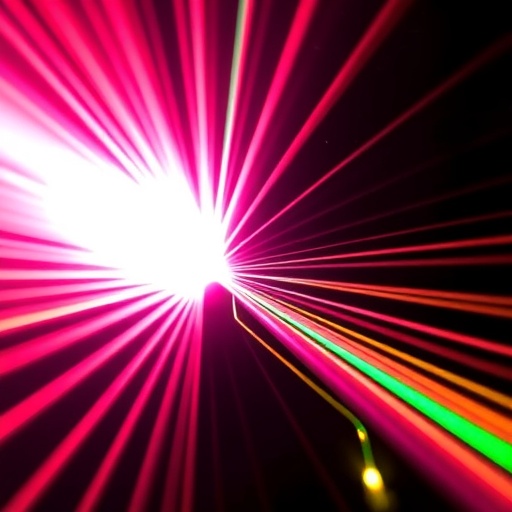
The laser system Wave Synthesizer 100 (LWS100) spans 11 metres in length and generates extremely short laser pulses.
view more
Credit: Mattias Pettersson
For the first time, researchers at Umeå University have demonstrated the full capabilities of their large-scale laser facility. In a study published in Nature Photonics, the team reports generating a combination of ultrashort laser pulses, extreme peak power, and precisely controlled waveforms that make it possible to explore the fastest processes in nature.
The custom-built laser system, called the Light Wave Synthesizer 100 (LWS100), spans 11 metres in length and 1.5 metres in width – far larger than many commercial lasers which are comparable in size to a pencil or a book. Its size is necessary to generate and amplify ultrashort laser pulses to extreme peak power. At its peak it generates 100 terawatts – equivalent to five times the average power consumption of the world – although only for a few millionth of a billionth of a second. This makes the system the most powerful laser in Sweden and opens the doors to groundbreaking applications like understanding ultrafast processes in biomolecules, developing light-driven electronics and improving solar panel efficiency.
What sets the system apart is that the pulses are not only extremely short (4.3 femtoseconds) and powerful – they also have a reproducible and controlled electric field waveform, identical from pulse to pulse. Achieving this level of control is particularly challenging in large-scale laser systems, but critical for many advanced applications. This can generate even shorter attosecond x-ray pulses that can be used to “film” the movement of electrons in real time.
“We can now show that the system delivers exactly what we envisioned when it was built. This is a milestone for our research,” says Laszlo Veisz, Professor at Umeå University.
A wide range of experiments are planned using this laser system, taking advantage of its extreme temporal and spatial light concentration. By shaping and focusing ultrashort pulses, attosecond electron bunches can be accelerated to ultra-relativistic energies in compact micro-accelerators, or next-generation X-ray sources can be created to advance attosecond science.
The laser system was installed and inaugurated at the Department of Physics at Umeå University in 2022. This newly published paper is the first scientific study to demonstrate its full performance.
Journal
Nature Photonics
Method of Research
Experimental study
Subject of Research
Not applicable
Article Title
Waveform-controlled field synthesis of sub-two-cycle pulses at the 100 TW peak power level
Article Publication Date
10-Jul-2025
Sara-Lena Brännström
Umea University
sara-lena.brannstrom@umu.se
Office: 907867224
Journal
Nature Photonics
Method of Research
Experimental study
Subject of Research
Not applicable
Article Title
Waveform-controlled field synthesis of sub-two-cycle pulses at the 100 TW peak power level
Article Publication Date
10-Jul-2025
Keywords
bu içeriği en az 2000 kelime olacak şekilde ve alt başlıklar ve madde içermiyecek şekilde ünlü bir science magazine için İngilizce olarak yeniden yaz. Teknik açıklamalar içersin ve viral olacak şekilde İngilizce yaz. Haber dışında başka bir şey içermesin. Haber içerisinde en az 12 paragraf ve her bir paragrafta da en az 50 kelime olsun. Cevapta sadece haber olsun. Ayrıca haberi yazdıktan sonra içerikten yararlanarak aşağıdaki başlıkların bilgisi var ise haberin altında doldur. Eğer yoksa bilgisi ilgili kısmı yazma.:
Subject of Research:
Article Title:
News Publication Date:
Web References:
References:
Image Credits:



